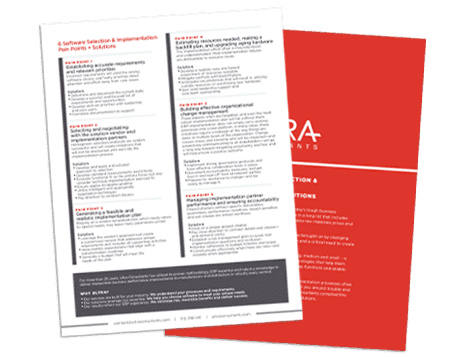For most ERP project teams, starting an ERP project is a daunting task. It’s common for selection teams to get pulled into a variety of directions, often losing focus because they are responding to pressing demands and fighting for internal resources to drive effective ERP selection.
It’s helpful to consider the genesis of most ERP projects. It’s often a combination of a company outgrowing legacy systems and being burdened with manual and standalone processes – common scenarios that leave the company with an unstable and ineffective technical environment.
Many organizations use a variety of manual methods, standalone spreadsheets and other patchwork systems to track data, and are in a poor position to react to change, optimize business processes such as production planning, or to improve relationships with customers and supply chain partners.
It’s also typical for legacy systems to deliver diminishing benefits because the software may be a victim of end-of-life “sunsetting” where support is discontinued. Another possible scenario involves the vendor putting the product in “maintenance mode” with limited updates. These legacy ERP software packages may no longer address the critical needs of today’s organization in areas of reporting, planning or overall efficiency.
For those organizations facing these challenges, oftentimes the most pressing question is how to start?

A Matter of Value
When it comes to starting an ERP project, Ultra’s team of ERP selection consultants suggests starting by taking a hard look at the value delivered by the current enterprise technology solution, to assess whether current systems can improve the way a business operates or if indeed an evaluation and selection project is necessary.
To help guide the value assessment, noted here are key areas to consider.
- What is the value that our current ERP system is providing?
- What is the value of a new ERP system?
- Can our existing ERP system match the value of the new ERP?
- Is our business being held back by the lack of an ERP system or one that is up-to-date?
Starting an ERP Project? Look at Current Value
In the case of assessing the current value of a legacy ERP system, the primary focus should be on the specific features and functions supported by the ERP system. Are they adequately supporting the business -not just the current state of business but the future state as well.
Another area to consider is the solution’s integration with external systems, applications, customers and suppliers to help manage the extended enterprise. Are there a multiple of “point solutions” and customer and supplier portals that aren’t fully integrated into ERP?
In terms of the end user experience, does the current ERP system offer an intuitive look and feel? Can users easily adapt screens? It’s common for small to mid-sized manufacturing and distribution companies to be using when AS-400 based ERP, with antiquated “green screens” from another era. We see users still struggling with legacy, user-unfriendly ERP solutions that demand programming expertise.
When considering current value of the ERP system, how robust are business intelligence capabilities? Does the system provide real-time visibility info areas like shop floor activity, capacity, inventory levels to fulfill orders and equipment effectiveness? Do users access easy to understand, “at a glance” dashboards and scorecards?
What about reporting? How easy is it to generate up to the minute reports that are accessible throughout the enterprise? Is there a need to Improve visibility and transparency of information?
Just Scratching the Surface
We’ve just scratched the surface of what to consider when starting an ERP project.
There is a proven methodology to help drive success beyond just looking at value of current systems– from business process mapping methods to setting ERP requirements.
Also worth exploring are the fundamentals of setting an ERP project charter.
After assessing value of the current system, and working through additional strategic analysis, you are likely in one of two places: you have accepted the realization it’s necessary to begin the process of evaluating and choosing a new technology solution or you are confident in your current system.
Choosing a new enterprise software solution is an important challenge and requires careful planning and research into potential solutions. Today’s modern technology supports business process improvements and best practices that lead directly to business performance improvement.
By approaching the evaluation process and ERP selection criteria in an informed manner, companies can ensure they make the right decisions to maintain or establish a competitive edge over other companies in the marketplace.
6 Software Selection & Implementation Pain Points + Solutions
Software selection and implementation processes often present challenges of their own. To steer you around trouble and help you drive success, Ultra’s experts compiled a list of pain points and solutions to be aware of as you embark on this journey.
Table of Contents
More ERP material...
Selecting the Right TMS System: Key TMS Features and Trends to Consider
Data analytics holds the ability to highlight inefficient manufacturing processes and enable…
Choosing a CRM System for Your Business
Data analytics holds the ability to highlight inefficient manufacturing processes and enable…
The Undeniable Benefits of Implementing ERP in Food and Beverage Manufacturing
Data analytics holds the ability to highlight inefficient manufacturing processes and enable…




